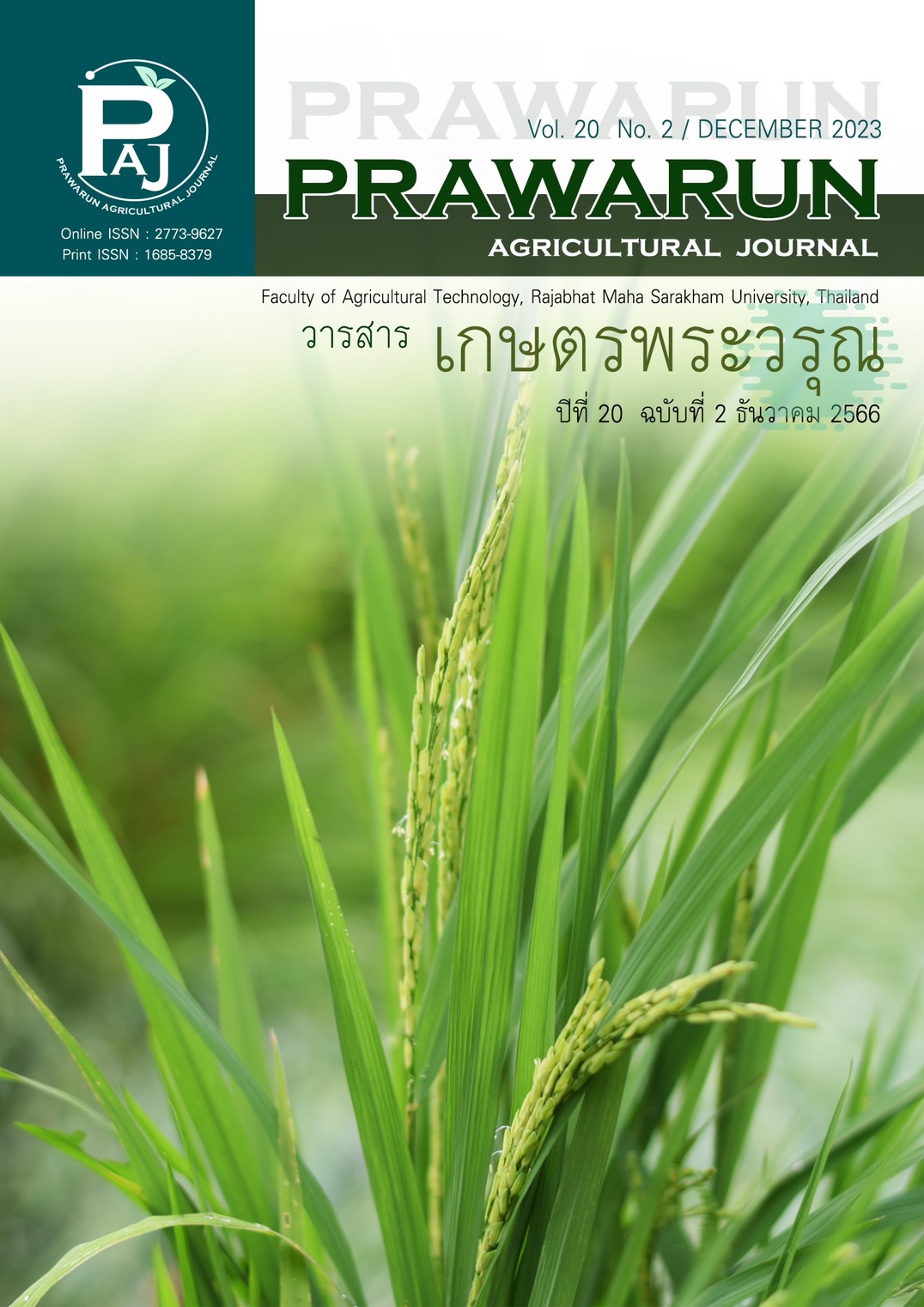การเปรียบเทียบสมรรถภาพการผลิต คุณภาพซาก และองค์ประกอบทางเคมีของเนื้อ ไก่เบตงกับไก่ประดู่หางดำ และไก่คอล่อนภายใต้ระบบการเลี้ยงแบบกึ่งปล่อย
Main Article Content
บทคัดย่อ
การวิจัยนี้มีวัตถุประสงค์เพื่อเปรียบเทียบสมรรถภาพการผลิต คุณภาพซาก และองค์ประกอบทางเคมีในเนื้อของไก่เบตงกับไก่ประดู่หางดำ และไก่คอล่อน ภายใต้ระบบการเลี้ยงแบบกึ่งปล่อย วางแผนการทดลองแบบสุ่มสมบูรณ์ ประกอบด้วย 3 กลุ่มการทดลอง ได้แก่ ไก่ประดู่หางดำ ไก่คอล่อน และไก่เบตง ที่อายุ 10 สัปดาห์ คละเพศ จำนวน 3 ซ้ำ ๆ ละ 15 ตัว จนกระทั่งอายุ 18 สัปดาห์ ใช้อัตราการเลี้ยง 2.5 ตารางเมตรต่อตัว โดยมีพื้นที่คอกดิน 5x7.5 ตารางเมตร ภายในมีเพิงขนาด 2x2.5 ตารางเมตร บริเวณที่เหลือเป็นพื้นหญ้าและพืชธรรมชาติ แต่ละคอกกั้นด้วยตาข่าย ผลการวิจัย พบว่า ไก่เบตงมีน้ำหนักตัว น้ำหนักตัวที่เพิ่มขึ้น ปริมาณการกินได้ต่อวัน อัตราการเจริญเติบโต อัตราการเปลี่ยนอาหารเป็นน้ำหนัก และต้นทุนค่าอาหารต่อน้ำหนักตัวที่เพิ่มขึ้น ตลอดช่วงอายุ 10-18 สัปดาห์ ไม่แตกต่างกับไก่ประดู่หางดำ และไก่คอล่อน (p > 0.05) เช่นเดียวกับคุณภาพซากของไก่เบตงที่มีน้ำหนักตัวก่อนฆ่า น้ำหนักซากอุ่น น้ำหนักซากเย็น และ % ซาก ไม่แตกต่างกับไก่ประดู่หางดำ และไก่คอล่อน (p > 0.05) ทั้งในเพศผู้และเพศเมีย แต่ไก่เบตงเพศเมียมี %ชิ้นส่วนสะโพกมากกว่าไก่ประดู่หางดำแต่ไม่แตกต่างกับไก่คอล่อน สำหรับค่าองค์ประกอบเคมีในเนื้อหน้าอก ได้แก่ %ความชื้น % โปรตีน และ % ไขมัน ของไก่เบตงไม่แตกต่างกับไก่ประดู่หางดำ และไก่คอล่อนทั้งในเพศผู้และเพศเมีย (p > 0.05) แสดงให้เห็นว่าการเลี้ยงไก่เบตงภายใต้ระบบการเลี้ยงแบบกึ่งปล่อย เป็นอีกทางเลือกหนึ่งของเกษตรกรที่สนใจเลี้ยงไก่พื้นเมือง
Article Details
เอกสารอ้างอิง
Association of Official Analytical Chemists (AOAC). (1990). Official methods of analyses (15th ed.). Washington, D.C.: Association of Official Analysis Chemists.
Buakeeree, K., & Nualhnuplong, P. (2016a). Effects of photoperiod on production performances and reproductive development of female Betong chicken (Gallus domesticus). Proceeding of the 3rd IBCELC conference (pp.45-51). Okinawa, Japan: Loisir Hotel Naha.
Buakeeree, K., & Nualhnuplong, P. (2016b.) Effect of dietary protein and energy levels on growth performances and reproductive system development in female Betong chicken (Gallus domesticus) during growing-pullet period. Khon Kaen Agriculture Journal, 44(3), 469-478.
Buakeeree, K., & Nualhnuplong, P. (2023). Estimation of growth curve of Betong chicken. Proceeding of the 3rd National and the 1st International MJU-Phare conference: creative technology and innovation for sustainable development goals (SDGs) (pp.676-682). Phare, Thailand: Maejo University Phare Campus. (in Thai)
Buakeeree, K., Thepparat, M., & Thepparat, T. (2018). The development of Betong chicken production for commerce in Klong Hoi Kong district, Songkhla Province. Prawarun Agricultural Journal, 15(1), 130-137. (in Thai)
Chanjula, P., Wanichapichart, W., Tongchumroom, T., & Laochareonsuk, S. (2004). Village Betong chicken production in three southernmost Thailand: a study of phenotypic characteristics, growth, carcass yield and egg performance of Betong chicken. Kasetsart Journal (Natural Science), 20(3), 278-288. (in Thai)
Castellini, C., Mugnai, C., & Dal Bosco, A. (2002). Effect of organic production system on broiler carcass and meat quality. Meat Science, 60(3), 219–225. doi: 10.1016/S0309-1740(01)00124-3
Chatreewong, D., & Waree, W. (2006). Optimum market age and weight of Betong chicken. Songklanakarin Journal of Science and Technology, 28(2), 311-319. (in Thai)
Chotesangasa, R., & Gongrattananun, N. (1999). Growth and carcass quality of native chicken raised under the natural day length and the photoperiod of twenty-three hours a day. Kasetsart Journal (Natural Science), 33(1), 60-74. (in Thai)
Fanatico, A., Pillai, P. B., Hester, P. Y., Falcone, C., Mench, J. A., Owens, C. M., & Emmert, J. L. (2008). Performance, livability, and carcass yield of slow-and fast-growing chicken genotypes fed low-nutrient or standard diets and raised indoors or with outdoor access. Poultry Science, 87(6), 1012-1021. doi:10.3382/ps.2006-00424
Intharachote, U., Leotaragul, A., Chormai, T., Jeendoung, T., & Prapasawasdi, C. (2008). Establishment foundation stock of four breeds of Thai indigenous chickens. Bangkok, Thailand: The Thailand Research Fund. (in Thai)
Kanto, U. (2009). Feed formulation. Nonthaburi, Thailand: Sukhothai Thammathirat Open University. (in Thai)
Molee, W., Khempaka, S., & Hormta, C. (2012). Effect of free range native chicken farming on growth performance, cholesterol content and fatty acid composition of meat. Nakhon Ratchasima, Thailand: Suranaree University of Technology.
Navanukraw, C. (1998). Hematology of farm animals and laboratory methods. Khon Kaen, Thailand: Khon Kaen University.
Nualhnuplong, P. (2019). Betong chicken production system in three border (Pattani Yala and Narathiwat) Provinces. (Doctoral dissertation). Songkhla, Thailand. Prince of Songkla University. (in Thai)
Od-Ton, V., Wattanachant, C., & Wattanasit, S. (2004). Phenotypic characteristics and carcass quality of Naked-Neck chicken reared under backyard production systems. Thaksin University Journal, 7(1), 58-67. (in Thai)
SAS. (1998). SAS User’s guide. Version 6.12. North Carolina, United States: SAS Institute Inc.
Simaraks, S., Chinrasri, O., & Aengwanich, A. (2004). Hematological, electrolyte and serum biochemical values of Thai indigenous chicken (Gallus domesticus) in northeastern, Thailand. Songklanakarin Journal of Science and Technology, 26(3), 425-430.
Trimanee, S., Sukarat, P., Auksornrat, C., & Chomai, T. (2013). Growth performance, economic returns and carcass and meat quality of Betong chicken under different raising system. In National livestock research and academic report 2013 (pp.757-763). Bangkok, Thailand: Department of Livestock Development, Ministry of Agriculture and Cooperatives.
Wang, K. H., Shi, S. R., Dou, T. C., & Sun, H. J. (2009). Effect of a free–range raising system on growth performance, carcass yield, and meat quality of slow-growing chicken. Poultry Science, 88(10), 2219–2223. doi: 10.3382/ps.2008-00423


